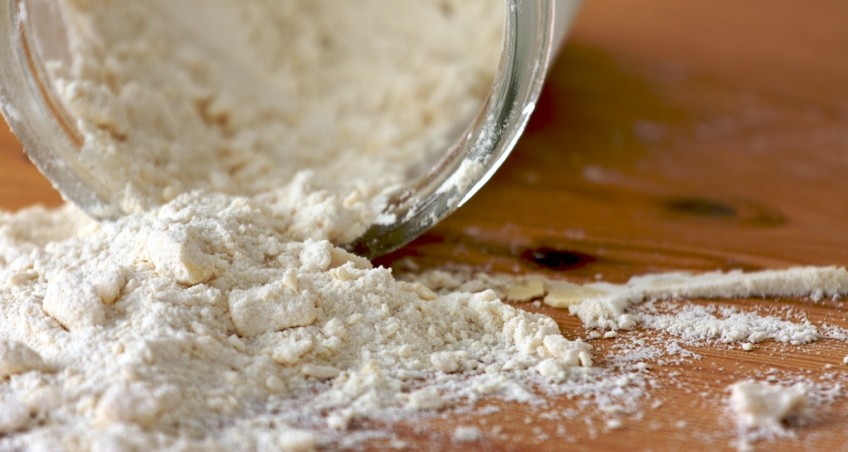Do you ever find yourself standing in the baking aisle of your local grocery store, wondering about the difference between self-rising flour and Bisquick? Well, you’re not alone. Many people are confused about whether or not Bisquick is a type of self-rising flour. Let’s break down the differences between these two ingredients to help clear up any confusion.

Table of Contents
Is Bisquick A Self Rising Flour?
The short answer is no. Bisquick is not a self-rising flour.
What Is Self-Rising Flour?
Self-rising flour is a type of pre-mixed flour that has been combined with salt and baking powder. This combination helps give baked goods an extra lift, especially when making quick bread like muffins, pancakes, and biscuits.
All you need to do is add wet ingredients—like milk or eggs—and start baking! It’s a great time saver since you don’t have to measure out separate ingredients.
What Is Bisquick?
Bisquick is also a pre-mixed biscuit mix made from all-purpose flour, baking powder, salt, and shortening. The main difference between Bisquick and self-rising flour is that Bisquick contains additional fat (in the form of shortening) in addition to the other dry ingredients.
This means that it can be used as a substitute for self-rising flour in some recipes, but it won’t yield quite the same results since it will make your final product heavier due to the added fat content.
FAQs
Can you use Bisquick instead of flour?
Yes, you can use Bisquick instead of flour for a variety of recipes.
In fact, Bisquick is a great substitute for flour when baking because it contains various ingredients like leavening agents and salt that are already incorporated in the mix. This makes it easier to create lighter, fluffier baked goods than if you were just using flour.
Additionally, Bisquick is a great gluten-free alternative to flour and can be used in many of the same recipes with minimal adjustments. All you need to do is substitute one cup of Bisquick for every one cup of flour your recipe calls for!
Keep in mind that some baking times may vary depending on the recipe, so make sure to adjust accordingly. With Bisquick, you can enjoy delicious gluten-free dishes without sacrificing flavor or texture!
However, it’s worth noting that Bisquick cannot replace flour completely in all recipes.
For example, yeast breads and some pastries require the addition of gluten to form and rise properly, so you’ll need to use wheat or other gluten-containing flours for those recipes.
Other than that, Bisquick is an incredibly versatile ingredient that can be used in a variety of recipes and baking projects. So don’t hesitate to experiment with Bisquick in your next culinary creation!
Read more: Tapioca Flour Nutrition Facts: How Many Carbs are in Tapioca Flour?
Can you fry with self-rising flour?
Yes, you can fry with self-rising flour.
Self-rising flour is a type of flour that has an additive such as baking powder and salt already mixed into it. This makes the flour good for recipes such as pancakes, waffles, and muffins because it provides a leavening agent which helps to make them light and fluffy.
It can also be used to make fried foods, such as chicken and fish. When frying with self-rising flour, use a shallow fryer or pot with at least two inches of oil heated up to 375 degrees Fahrenheit. Dip the food into a bowl of self-rising flour and then carefully place it into the hot oil using tongs. Fry for about four minutes, until golden brown on both sides. Drain the fried food on a paper towel-lined plate to absorb any excess oil before serving.

Can you make gravy with Bisquick?
Yes, you can make gravy with Bisquick! Making a tasty gravy with Bisquick is easy and quick.
All you need to do is mix together Bisquick, cold water, and seasonings of your choice. Then simply heat the mixture in a saucepan until it boils then reduce the heat so that the gravy simmers until it has reached the desired consistency.
You can also add some cooked onions, mushrooms, or other vegetables if you like! When it’s finished, your delicious gravy is ready to be served over mashed potatoes, chicken, and more.
Can you use self-rising flour to make gravy?
Yes, self-rising flour can be used to make gravy.
It is a type of flour that contains baking powder and salt, which helps the gravy thicken when added to liquids like stock or broth. Self-rising flour also helps stabilize the fat molecules in the gravy and prevents them from separating out.
To use it for making gravy, first cook the meat and vegetables in a skillet, then gradually sprinkle in self-rising flour while stirring. Add broth or stock to the pan and continue stirring until the gravy reaches your desired consistency.
To add flavor, season with herbs and spices like salt, pepper, thyme, sage or parsley.
The best part about using self-rising flour to make gravy is that it is quick and easy. Not only can you avoid the long process of making a roux with butter and flour, but you also don’t need to worry about adding the correct proportions of baking powder and salt. Just add the self-rising flour directly into the skillet and start stirring.
Plus, because it is already blended with baking powder and salt, you’ll get a more even flavor throughout your gravy. Give it a try!
Conclusion
So there you have it! Self-rising flour and Bisquick are both great options for making quick bread, but they are not interchangeable in all recipes due to their different ingredient and makeup. If you’re looking for a time saver in the kitchen, both self-rising flour and Bisquick can be great additions to your pantry staples! Now that you understand the difference between these two ingredients, why not give them both a try? Happy baking!
References:
https://owyheecounty.net/wp-content/uploads/2015/12/Dutch-Oven-Cooking-Recipes.pdf








